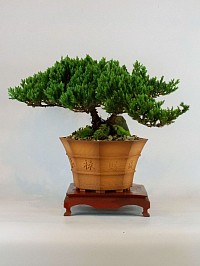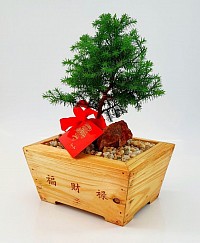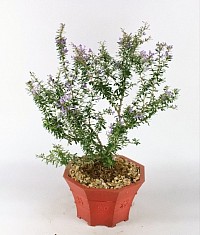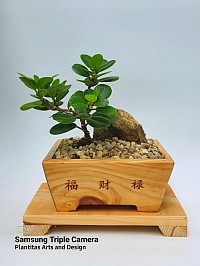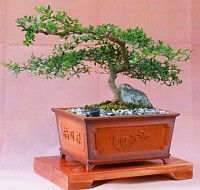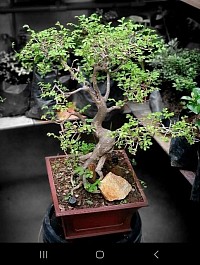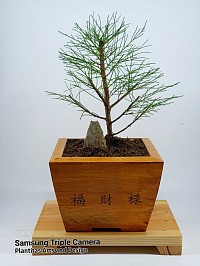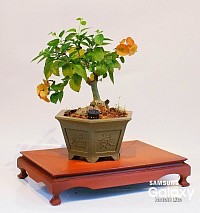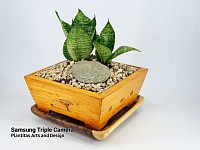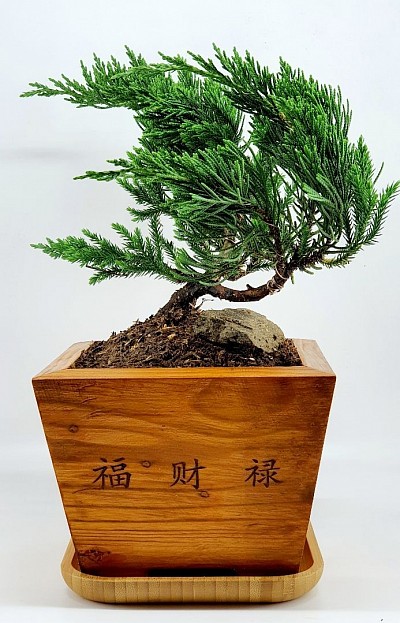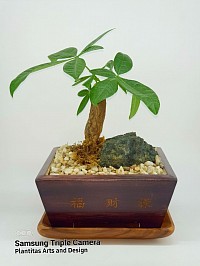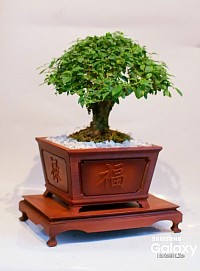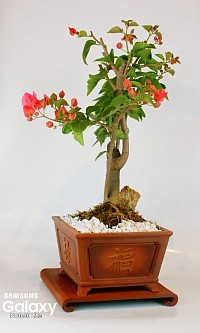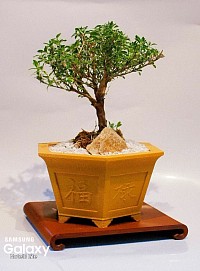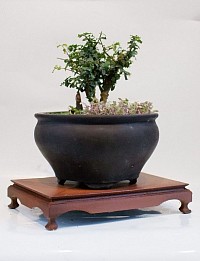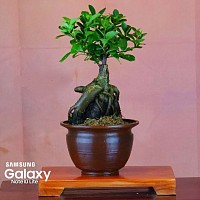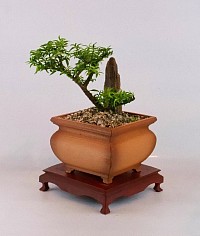Plant Care Tips
Our Plant Care Tips
Juniper Bonsai Care
Junipers are ideal for the bonsai beginner. They are easy to care for and if grown with the right conditions,it will reward you with its beauty and form. Junipers resembles a tree like form when the foilage thickens. It need minimal or no prunning at all. It as beautiful as it grows.
Before grabbing your scissors and start shaping that tree on your mind with your newly purchased Juniper.... please read through.
Junipers need very little to no prunning. You can cut those dead braches though but other than that, leave those bright green tips alone. Those tips are where junipers get their energy. If the stems have outgrown your intended shape, then that's the time you cut it.
Watering. These plants can tolerate droughts, but also welcomes regular watering. Fast draining soil mix is ideal.
Junipers love full sun so find a place where it recieved direct sunlight at least 4-5 hours a day. If such is the case, it will reward you with lush green foilage in a few months.
Fetilizers. You can use slow release balanced fertilizers. 14-14-14 or 20-20-20 should be fine. Take note of the amount vs the pots sized. Do not place it over roots. Cultivate it into the soil away from the roots, near the pot edges should be OK.
Silver Pine Plant Care
Bluebell Plant Care
1. Lighting: In a tropical country like the Philippines, bluebell flowering bonsai plants should be placed in a location with bright, indirect sunlight. Avoid direct sunlight during the hottest part of the day, as it can scorch the leaves. If the sunlight is too intense, you can provide some shade during midday hours.
2. Watering: Tropical climates can be humid, so it's important to balance watering to avoid overwatering. Water your bluebell flowering bonsai plant when the top inch of soil feels dry. Ensure that the pot has good drainage to prevent waterlogging. During the rainy season or periods of high humidity, you may need to adjust the watering frequency accordingly.
3. Fertilizing: Fertilize your bluebell flowering bonsai plant regularly during the growing season using a balanced liquid fertilizer. In a tropical climate, where plants grow vigorously, you may need to fertilize more frequently. Follow the instructions on the fertilizer packaging for dilution and application rates.
4. Pruning: Regular pruning is essential to maintain the shape and size of your bluebell flowering bonsai plant. Prune back any excessive growth or unwanted branches to maintain a balanced form. Additionally, remove any dead or diseased parts to promote overall health.
5. Temperature and Humidity: In a tropical country like the Philippines, the temperatures are generally warm throughout the year. Bluebell flowering bonsai plants thrive in temperatures between 65-80°F (18-27°C). Maintain a consistent indoor temperature within this range. However, in certain areas of the Philippines where temperature variations occur, you may need to protect the bonsai from extreme heat or cold by moving it to a more suitable location. Bonsai plants also benefit from increased humidity, so misting the leaves regularly or placing a tray of water nearby can help create a humid microclimate.
Ficus Plant Care
Ficus plant are tropical by nature so it must be kept consistently warm for it to survived. Indirect sunlight are best. Once settled in a specific location, it does not tolerate being moved cause even a slight change in climate or location can cause the leaf to drops or the plant to die.
Keep the room humid. Misting the leaves during summer months will greatly help.
Wipe the leaves with a wet cloth every week to keep it free from dust. Remove any buildup of apids underneath.
Prune branches so that the center of the tree is getting enough sunlight. Doing so, the tree can fully grow.
Bucida Bonsai Plant Care
Bucida is a small low and picturesque spreading plant that can grow up to 4 feet in height. The branches will grow horizontal unless you trained it with wires. It gives a layered appearance.
There is no special care required except regular watering.... it loves a lot of water and sun. Keep the soil moist at all times as leaves tends to turn yellow and drop. But don't worry, it will start to grow back quickly once the condition is corrected. It's a sun loving plant although some some succes can be achieved indoors, you will have better luck outdoors.
You can add a spoon of slow release fertilizer anytime in 6 - 8 months interval and that's it. Prune dead branches to grow new ones as shoots at the top of the plant. These will turn into hard branches so you have to train it early if you want to. It has very few pest enemies so no need to worry about that.
Remember... lots of water.
Chinese Elm Care
Chinese Elm bonsai are beautiful and popular choices among bonsai enthusiasts. Here are some general care instructions to help you keep your Chinese Elm bonsai healthy and thriving:
1. Placement: Chinese Elm bonsai can be kept both indoors and outdoors. However, they prefer a location that receives ample sunlight, preferably 4-6 hours of direct morning or afternoon sunlight each day. If kept indoors, place the bonsai near a window that provides bright, indirect light.
2. Watering: It's important to keep the soil of your Chinese Elm bonsai evenly moist but not waterlogged. Check the soil regularly by inserting a finger or a moisture meter into the soil. Water thoroughly when the top inch of soil feels slightly dry but before it becomes completely dry. Avoid overwatering or allowing the roots to sit in water for a prolonged period.
3. Humidity: Chinese Elm bonsai thrive in moderate humidity. To increase humidity, you can place the bonsai on a humidity tray filled with water and pebbles. As the water evaporates, it will create a humid microclimate around the bonsai.
4. Fertilization: Feed your Chinese Elm bonsai with a balanced bonsai fertilizer from spring to autumn. Follow the instructions on the fertilizer package for proper dosage. Reduce fertilization during winter or when the bonsai is in a dormant phase.
5. Pruning and Trimming: Regular pruning and trimming are necessary to maintain the desired shape and size of your bonsai. Prune back new growth to the desired length, maintaining the overall balance of the tree. Trim any unwanted branches or leaves to encourage proper growth.
6. Repotting: Every 2-3 years, Chinese Elm bonsai should be repotted to refresh the soil and promote healthy root growth. Repot during early spring, before the buds start to open. Use a well-draining bonsai soil mix, and after repotting, water thoroughly and keep the bonsai in a shaded area for a few weeks to recover.
Remember, these are general guidelines, and specific care requirements may differ based on your specific Chinese Elm bonsai and local climate conditions. Observing your bonsai closely and adapting care as needed will help ensure its long-term health and beauty. Enjoy the art of bonsai!
Agoho Pine Bonsai
This species is native to South East Asia and Northern Australia.
They are commonly called Autralian pine tree or whistling pine. In Philippines, we call them Agoho Pine. The foilage are thin scaly leaves and its trunk are brown and rough textured which makes it a very good bonsai specimen.
Agoho pine need full sun to thrive. Although it can withstand cold climate it's a warm tropical tree. This means you can bring it inside your air-conditioned living or dining rooms to get the feel of nature. Bring it outside on most days of the week for the much needed sunlight. They prefer moist soil mixed with some organic matter. Prune only when the tree out grows the intended shape.
These plants are resistant to pest and diseases and can live up to 50 yrs. Yes, they will outlive you if you take good care of them. Water regularly. Keep the soil moist and they will love you for it.
Chinamanshat Bonsai Care
Growing this kind of tree is fairly easy. If you got this from us, it comes with a well draining loam soil. This insure you won't overwater your tree. It's not weather sensitive like other pines and it can thrive in both outdoor or indoor (with reasonable light). They grow best with indoor cool temperature near windows or patios. Rotate the pot daily so that all sides recieved a share of sunlight. Foilage tends to turn brown if it's getting less sunlight. Target for 6 hrs sunlight as minimum to get consistent flowering.
You can feed the tree with a balance slow release fertilizer. Water only when the top soil has dried. A full bath once a week and the tree will reward you with lush yellow green lemony scented foilage while relaxing in your favorite part of the house. Happy growing!
Dwarf Snake Plant Care
This is one tough plant that you probably can't kill. It's drought tolerant so you can forget watering for a week and this will keep purifying the air for you while you sleep. It can also tolerate overwatering to some extent. This will survive in least amount of light so you can keep curtains shut it won't mind Unless you want them to grow fast.
Watering once a week should be fine. Watch out for babies in a few weeks. They spread underground stems which pops out as new growth.
Buffalo Juniper
Buffalo Junipers are great bonsai materials. At maturity, he trunks grow thick that based on its overall height and spread, resembles a tree in distress. the secondary stems are soft which are good for wiring for your prefered bonsai form.
This plant can withstands drought, salt, and city conditions.
The soils we used are loam soil. You can water dailly depnding on the location. if you choose indoor then you can reduce the watering frequency.
Tolerates poor soil, heat, and drought. Best in slightly alkaline, fertile but well-drained soil. Prune to maintain desired shape. Wear gloves when handling to avoid skin irritation.
Money Tree Plant Care
Money trees are considered a symbol of luck and prosperity. It became popular in Japan and East Asia, also becoming associated with the Chinese practice of Feng Shui.
The five leaves seen on each stalk are thought to represent the five elements of earth, water, fire, wind, and metal.
Money tree plants do best in warmer environments, an area that's between 22 and 28 degrees C should be fine. Although it's an indoor plant, it will still appreciate good sunlight exposure , so take it out while having coffee at your favorite outdoor garden spot. But, the good news is, money trees are also pretty flexible and forgiving—they can still handle temperatures that go 10 degrees below or above that ideal range.
Money trees thrive with extra moisture, so make sure you mist your plant regularly.
Give it a good watering every 3 to 4 days, allowing the soil to dry in between, actually this depends on where it is. if your plant is getting more light, you'll also need to up its water intake so it doesn't get too dried out. This is a plant that requires a lot of water, but not all the time.
A handfull of balance slow release fertilizer should be fine in 6months interval or so...not too much Ok... remember less is more when it comes to feeding.
Tugas (Molave) Bonsai Plant Care
Tugas (Molave) is quite forgiving in terms of plant care. Its also a favorite of bonsai enthusiast due to its thick foilage. Also one of the most attractive forms in the bonsai world.
Choose a sunny well lit spot to place you plant. they love a good amount of light preferably 6 hrs a day. they can tolerate drought so you can skip watering every other day they should be fine. make sure to soak them once a week.
A slow release fertilizer from ace HW shouls be ok . Pick one that says balance 14-14-14 or 20-20-20. An orchid fertilizer would do fine as well.
Pruning is required. take the dead brown branch out to keep it healthy greens. These dead branches promote diseases so make it a habit to take them off of you tree. Prunning to keep the intended shape is you goal.
These are just some tip. For other concern you can email us and we would be glad to give you more guidance in growing you bonsai. Happy planting!
Santan Bonsai Plant Care
Santan or Ixora coccinea is a flowering shrub native to tropical countries like the Philippines. It doesn't require much care at all, too—just grow under full sunlight and trim to control growth.
The blossoms of the Santan plant (aka Ixora coccinea) is probably most popularly known as the distinct red-colored, star-shaped flowers we used to make crowns, necklaces, or bracelets with our playmates during our childhood.
We potted our Santan plants in acidic loam soil rather than an alkaline one as is has a tendency to grow quite a bit. You need to control the growth by shaping them. You can follow the initial pods when you acquired from us or shape them to a more decent size to your liking. Ixora responds well to shearing and makes an excellent low hedge When they are actively growing, they need regular watering. Just make sure not to overwater them—they need bone-dry soil before their next hydration. Keep the soil evenly moist. Water them every morning especially during summer Never let the soil dry but do not overwater.
Plant your santan in full sunlight or partial shade, full sunlight results in more generous blooms.
Proper fertilization, pruning, and placement can help Ixora survive in the landscape. A good palm fertilizer such as 8-2-12-4, the fourth number on a fertilizer bag is Mg (magnesium), with chelated micronutrients and 100 percent slow-release N, K and Mg is recommended, applied four times per year. If you think that light and soil conditions are adequate, you might water in a low-phosphorus fertilizer. And you might sprinkle Epsom salt around the plants and water it in. This will help the ixora absorb necessary nutrients that encourage flowering.
Bougainvilla Bonsai Plant Care
Bougainvillea likes it dry. It prefers a good, deep watering every three or four weeks to frequent shallow waterings. Give a bougainvillea too much water and it can get fungal diseases and root rot. Bougainvillea blooms better when kept on the dry side.
These are dazzling shrubs of leaves and flowers that are moderately easy to grow and perfect for those who want a vibrant addition to their garden.
Bougainvilleas love the heat! They require at least six hours of full sunlight a day and can handle even the hottest of summers. If you want your plant to produce an abundance of flowers, make sure it’s sitting in direct sunlight. Oftentimes when bougainvilleas struggle to bloom, it’s because they aren’t receiving enough light, which will cause the plant to look thin and sparse.
Potted bougainvilleas require regular watering. During the hot months, you can expect to water your plant at least 4X-5X a week. If temperatures reach over 37C – 40C consider watering your flowers daily ensure they’re well hydrated. \
Bougainvilleas are considered tropical plants and prefer to grow in warmer climates.
Due to the sap the plant produces, bougainvilleas are considered mildly toxic to pets. The leaves themselves are not toxic, but a single prick from one of the thorns can lead to skin infections or an allergic reaction, so make sure you keep an eye on your pets!
If ingested by humans, bougainvilleas are not toxic or considered a poisonous plant. Our bodies can handle ingesting a plant like this one, but many animals, like cats and dogs, may experience mild illness or symptoms.
Though bougainvilleas are typically pest-free, they can occasionally attract pests like aphids, thrips, spider mites, slugs and caterpillars. If you come across a pest problem, consider spraying them with a mixture of dish soap and water, using neem oil or buying an insecticide if you want a harsher solution.
Like many other plants, bougainvilleas can be susceptible to common diseases such as root rot, leaf spots and nutrient deficiencies. To avoid this, be sure your bougainvilleas are well-drained and receive enough water and sunlight.
Since bougainvilleas are known for their fast-growing habits, regular repotting is recommended to ensure they don’t outgrow their pot.
Be sure to take into account the temperature your plant is growing in — in the colder months, you won’t need to water the plant as often as the summer months
With proper care, bougainvilleas are known to last year-round when planted outdoors. They thrive in the heat and can withstand colder temperatures
Serrissa Bonsai Plant Care
The Serissa is an evergreen or semi-evergreen tree with fine oval, shiny green leaves. Foliage and roots have an unpleasant smell if damaged. Except for its lovely flowers, the serissa is valued for its fine ramification and rough grey bark.
The serissa likes a sunny, wind-protected place outside Drastic temperature drops are not tolerated. Avoid unnecessary changes of the tree's position, The warmer the position the more light is needed. Grow lights can help. Try to provide high humidity.
Keep the rootball moist, but at the same time take good care not to overwater the serissa Bonsai tree. It must never dry out completely. If the tree drops its leaves due to some changes in the growing conditions, continue but slightly decrease watering. The serissa likes a neutral pH value (7), so avoid very calcareous water. When no flowers are on the tree, it is a good idea to often spray the foliage with lime-free water.
Apply a small amount of solid organic fertilizer every four weeks or use a liquid fertilizer in a low concentration every week during the growing season. Use a fertilizer with a balanced N-P-K ratio like 14-14-14 or similar. Do not fertilize unhealthy or not growing serissas.
The serissa tolerates hard pruning. Young trees are trimmed back to 2 leaves when the shoots have produced 4 – 5 leaves. Older trees are trimmed less as long they are flowering, but are pruned thoroughly after flowering. Every two or three years the branches must be cut back to old wood in order to keep the tree shape compact. Branches and shoots can be wired at any time, but they are delicate and must be wired with great care. Remove the wire after approximately six months before it cuts into the bark.
Repot the serissa every two years and use a standard soil mix or loam soils. Prune the roots only moderately. The roots smell unpleasant when they are cut.
The serissa can easily be propagated from semi-hardwood cuttings.
Chinese Holly Bonsai Care
Chinese Holly is a holly from Asia where it is often found in ravines and hills and alongside mountain paths.
No. you can't grow hollies indoors. This need full sun but can tolerate partial shade. The plants are evergreen and provide year round interest though, so hollies are still great.
Too much shade will reduce blooming, and therefore berry production, but this bush grows well with minimal direct sunlight. It grows best in richer, moist soils, but they must be well-drained, so avoid areas with standing water.
Water daily we are in tropical country, so water dries up quickly. Weed often, and prune regularly so that the holly doesn't choke itself out. This bonsai loves a frequent haircut to grow more shoots. One trick I've found to "densen up" hollies is shearing. Hollies are good at pushing out new leaf buds even when you cut back into bare wood. The cuts often stimulate new growth from multiple buds, giving the plant a fuller habit as the new leaves grow.
Too much shade will reduce blooming, and therefore berry production, but this bush grows well with minimal direct sunlight. It grows best in richer, moist soils, but they must be well-drained, so avoid areas with standing water.
Fertilize Chinese hollies at rates recommended on the product label with a slow-release shrub & tree type fertilizer that contains iron and/or sulfur for deep greening. Normally a palm full is enough. Alternatively, you can feed plants with an organic plant food.Fertilize once a year. Apply fertilizer away from the roots as much as possible.
Ficus Ginseng Bonsai Care
Ficus Ginseng Bonsai Trees are a popular type of indoor bonsai tree. They are easy to care for and make a great addition to any home.
The Ficus Ginseng is a great houseplant for beginners. It's not one of the most difficult plants to take care of, but it's still a beautiful and unique plant. Let's look at how we can give your Ficus the best care we can and help it thrive in your house!
A Ficus Ginseng enjoys moist soil most of the time but doesn't like to have wet feet. When your Ficus is exposed to too much water for too long, it will quickly develop root rot and die. Luckily, there are a few things you can do to make sure this doesn't happen.
• Only water your Ficus when the soil is completely dry
• Use a pot with a drainage hole to drain excess water from the pot
• Use well-draining soil to hold onto some of the water, but not too much
• When watering your Ficus, be sure to water it thoroughly and then allow the soil to dry out completely before watering again. Watering your plant thoroughly makes sure that all the soil has a chance to soak up the moisture before draining it to the bottom of the pot. Overwatering is one of the most common problems with ficus trees, so be sure to wait until the soil is completely dry.
• If you're ever unsure whether or not to water your ficus, it's better to wait a few extra days. If your Ficus has been dry for too long, it tends to drop a few brown and crispy leaves, so make sure to water before that happens. This might take a little experimentation. In Philippines with hot summer months, water dries in a day so you should be ready to water it every day.
Your ficus tree will need plenty of bright, indirect light. If you notice that the leaves are starting to turn yellow or brown, it's a sign that your Ficus Ginseng is getting too much sunlight. Bright and indirect sunlight is ideal, but a few hours of direct sunlight in the morning is fine too, as long as it doesn't get the stronger direct sunlight in the afternoon. The direct sunlight in the afternoon will be too bright and warm for this plant.
Fertilize your ficus tree every few weeks during the growing season with a balanced fertilizer. Liquid fertilizer is easiest, as you can add this to the water, and your Ficus absorbs it quickly. All fertilizer is different, so make sure to follow the instructions on the packaging carefully. If you fertilize too often or with too much fertilizer, you can burn the roots of your ficus tree.
During the winter, you shouldn't fertilize your Ficus Ginseng, as it'll be in its winter dormancy and won't need the fertilizer. As soon as it gets to the beginning of march, you can start to fertilize your Ficus again, as this is the early spring and your Ficus is about to grow quite quickly.
The best soil mixture for a Ficus Ginseng is a well-draining potting mix. You can find this at most garden stores or online. Loam sold should be fine too. This well-draining soil mix is also quite easy to mix yourself. You can mix your soil for the ficus ginseng by mixing 2 parts potting soil with 1 part peat moss and 1 part perlite.
Ficus trees are relatively easy to care for, but like all plants, they can be susceptible to pests and diseases. The most common pests on a ficus Ginseng are scale insects and mealybugs. These pests can cause damage to the leaves and branches of the tree, and can also lead to the development of fungal diseases.
If you notice any signs of scale or mealybug infestation, take action immediately to get rid of them. You can get rid of these pests by using insecticidal soap, neem oil, or simply wiping the pests off with a damp cloth. Be sure to check your Ficus regularly for any signs of problems and take action immediately if you see anything out of the ordinary.
Pruning your plants is a great way to promote growth, get rid of dead leaves, and shape your plants exactly how you want! Just like any other houseplant, you can and probably should prune your Ficus Ginseng as well!
You should prune your Ficus in late winter or early spring before any new growth begins. Prune off any dead or damaged branches with sharp scissors or pruning shears. If you're using your Ficus as a true Bonsai, this is the perfect time to shape your tree how you'd like it to look! Be careful not to prune too much, as this will reduce the amount of foliage and sap production.
If you've taken excellent care of your Ficus Ginseng for a year or more, it probably grew quite a bit. However, now it seems to have stopped growing in the middle of spring or summer. This means it might be time to repot your plant!
You know your Ficus needs to be repotted when the plant becomes root-bound. You can easily see if your Ficus is root-bound by carefully lifting it out of the pot to check the roots. If you see more roots than soil and if the soil is very tightly packed around the roots, your plant is officially root-bound. Repotting the Ficus Ginseng in a bigger pot will give the plant more space to grow and will help keep it healthy.
The best time to repot a Ficus Ginseng is in the springtime when the plant is coming out of its winter dormancy. You should wait until the soil is dry to the touch before repotting, and then gently remove the plant from its pot. If the roots are grown out of control, you can cut them back with sharp scissors before repotting. If you're using a shallow pot, trimming the roots a little is a great idea, because this keeps the roots compact and helps with the overall health of your Ficus. Be sure to choose a pot that is only slightly larger than the original pot, and pack fresh soil around the roots before watering well.
It's very important to use a pot that's only slightly bigger than the current pot because if you plant your Ficus in a pot that's far too large, it's very easy to overwater your plant and cause root rot.
Water Jasmine Bonsai Care
Here is a basic plant care guide for Water Jasmine
1. Lighting: Water Jasmine Bonsai thrives in bright, indirect sunlight. Place your bonsai near a window where it can receive at least 4-6 hours of sunlight daily. Be cautious of direct, intense sunlight, especially during the peak afternoon hours, as it can scorch the leaves.
2. Temperature: Water Jasmine Bonsai prefers warm temperatures between 70-90°F (21-32°C). A stable temperature is important for its growth, so avoid placing it in areas with extreme temperature fluctuations or drafts.
3. Watering: Ensure proper watering to maintain a healthy Water Jasmine Bonsai. Water thoroughly when the topsoil feels slightly dry to the touch, but make sure not to let it completely dry out. Avoid over-watering, as it can lead to root rot. Regular misting of the leaves can help maintain humidity levels.
4. Humidity: Water Jasmine Bonsai enjoys higher humidity levels. To increase humidity, you can place a tray with water and pebbles beneath the bonsai or use a room humidifier. Avoid placing it near air conditioning vents or other sources of dry air.
5. Soil: Use a well-draining soil mixture suitable for bonsai, such as a mix of akadama, pumice, and lava rock. This ensures proper drainage and prevents waterlogged roots. Regularly check the soil's moisture level to adjust your watering frequency accordingly.
6. Fertilization: Feed your Water Jasmine Bonsai with a balanced, organic liquid fertilizer during the growing season (spring to early fall) to promote healthy growth. Follow the instructions on the fertilizer packaging for proper dosage and application frequency.
7. Pruning and Shaping: Regular pruning helps maintain the desired shape and size of your Water Jasmine Bonsai. Prune back new growth to maintain the desired shape and remove any dead or yellowing leaves. Wiring can be used to shape the branches, but be gentle to avoid damaging them.
8. Repotting: Repot your Water Jasmine Bonsai every 1-2 years during early spring. This allows for root maintenance and ensures proper nutrient uptake. Trim the roots during repotting and use fresh bonsai soil to give them space to grow.
9. Pest Control: Keep an eye out for common pests such as aphids, whiteflies, and mealybugs. Treat infestations promptly with organic insecticides or by gently wiping the leaves with a soapy water solution.
Remember, proper care and attention play a vital role in the healthy growth of your Water Jasmine Bonsai. Observing your bonsai closely and adjusting care techniques accordingly will help ensure its overall well-being.

